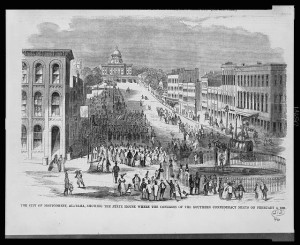From the Richmond Daily Dispatch March 23, 1863:
A Spy Hung.
–Saturday morning last the Vigilance Committee resumed the examination of Dan’l S. E. Starr, who was charged with having written an Abolition book, which we believe, was found in his possession; but as the examination was conducted in secret we only speak from common report. It is understood that he had counsel at this examination. About 3 o’clock P. M.Starr was sent to jail to await a trial before the Circuit Court. But the sequel shows that he will never again appear before an earthly tribunal. Daylight Sunday morning revealed his body dangling from the limb of a tree in or near the revine in the north part of the city. How it got there will probably never be made public. The body was taken down by his relatives and in the afternoon decently interred.–Montgomery (Ala.) Mail
A book about Southern Unionists provides some more information about this incident. [1] Starr was a brickmason from Connecticut who lived with his wife and kids on the outskirts of Montgomery. His “Abolition Book” may have been sort of a defiant journal that “reflected poorly on the Confederacy and some local men.” He might let others know about his writings when he got drunk once. The consensus in Montgomery was that he was “an advocate of black equality and a Yankee traitor.” Starr’s murderers were never apprehended. Other Unionists in Montgomery were worried that the Starr hanging might provoke similar attacks against themselves, but that never happened.
The practice of hanging Unionists occurred earlier in American history. For example, Loyalists were hung from the Tory Oak in Wilkesboro, North Carolina. An patriot militia colonel used the tree to execute loyalist militia leaders.
- [1]Inscoe, John C., and Robert C. Kenzer, eds. Enemies Of The Country: New Perspectives On Unionists In The Civil War South. Athens, Georgia: University of Georgia Press, 2001. Print. pages 182-183.↩


![The savages let loose, or The cruel fate of the Loyalists ( Sold by W. Humphrey No. 227 Strand, [1783 March]; LOC: LC-USZC4-5256)](https://www.bluegrayreview.com/wp-content/uploads/2013/03/3g05256r.jpg)